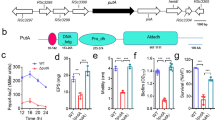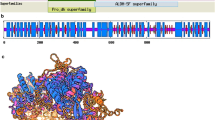Summary
Salmonella typhimurium can degrade proline for use as a carbon, nitrogen, or energy source. To determine whether a futile cycle occurs which degrades the proline accumulated by proline biosynthesis, we studied the expression and enzymatic activity of the proline utilization (put) pathway under conditions which increase the concentration of the intracellular proline pools: catabolism of the dipeptide glycyl-proline, overproduction of proline due to a mutation which prevents feedback inhibition of proline biosynthesis, and accumulation of proline due to osmotic stress. The results indicate that: (i) internal proline induces the put genes, but only when accumulated to concentrations greater than the normal proline biosynthetic pool; and (ii) degradation of proline pools accumulated under high osmotic pressure is limited because proline oxidase is directly inhibited under these conditions.
Similar content being viewed by others
References
Beatriz A, Olfson P, Casadaban M (1984) Plasmid insertion mutagenesis and lac gene fusion with mini-mu bacteriophage transposons. Proc Natl Acad Sci USA 158:488–495
Csonka LN (1981) Proline over-production results in enhanced osmotolerance in Salmonella typhimurium. Mol Gen Genet 182:82–86
Csonka LN (1989) Physiological and genetic responses of bacteria to osmotic stress. Microbiol Rev 53:121–147
Csonka LN, Baich A (1983) Proline biosynthesis. In: Herrman KM, Sommerville RL (eds) Amino acids: Biosynthesis and regulation. Addison-Wesley Reading, Mass, pp 35–41
Dendinger S, Brill W (1970) Regulation of proline degradation in Salmonella typhimurium. J Bacteriol 103:144–152
Hahn D, Maloy S (1986) Regulation of the put operon in Salmonella typhimurium: characterization of promoter and operator mutation. Genetics 114:687–703
Hughes K, Roth J (1984) Conditionally transposition-defective derivative of Mudl(Amp, Lac). J Bacteriol 159:130–137
Maloy S (1987) The proline utilization operon. In: Neidhardt FC, Ingraham JL, Low KB, Magasanik B, Schaechter M, Umbarger HE (eds) Escherichia coli and Salmonella typhimurium: Cellular and molecular biology. American Society for Microbiology, Washington, DC, pp 1513–1519
Maloy S (1989) Techniques in bacterial genetics. Jones and Bartlett Publishers, Boston, Mass
Menzel R, Roth J (1981) Enzymatic properties of the putA protein from Salmonella typhimurium. J Biol Chem 256:9762–9766
Miller J (1972) Experiments in molecular genetics. Cold Spring Harbor Laboratory, NY
Sanderson K, Roth J (1988) Linkage map of Salmonella typhimurium, Edition VII. Microbiol Rev 52:485–532
Author information
Authors and Affiliations
Additional information
Communicated by J.W. Lengeler
Rights and permissions
About this article
Cite this article
Ekena, K., Maloy, S. Regulation of proline utilization in Salmonella typhimurium: How do cells avoid a futile cycle?. Mol Gen Genet 220, 492–494 (1990). https://doi.org/10.1007/BF00391761
Received:
Issue Date:
DOI: https://doi.org/10.1007/BF00391761




